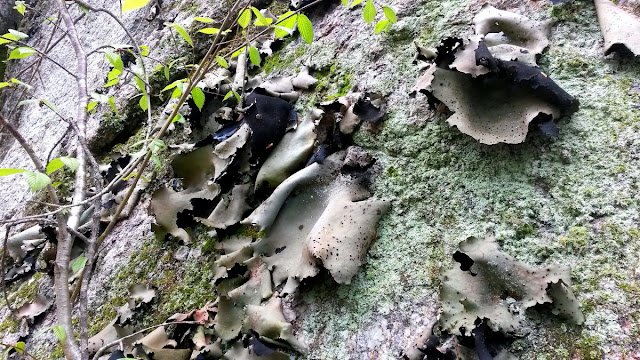 |
| Rock Tripe (genus Umbilicaria) growing in the Smyth Conservation Easement |
Rock Tripe is a lichen, which are composite organisms made up of at least two, and sometimes three, very different organisms. One component of lichen is always a fungus, and the second is usually an algae. The algae lives inside the fungus and the two organisms exchange nutrients - not unlike what a fungus does for a tree. And since algae can photosynthesize using sunlight, CO2, and a few nutrients, [REF: http://allaboutalgae.com/what-are-algae/] it can provide energy to the fungus, which in turn, provides a home for the otherwise structure-less algae. It's a pretty nice arrangement, and can produce some really large Rock Tripe.
These are nice and green, but in a dry season or on a sunny ledge they can be brown, dry, and stiff.
In case you're ever hungry in the woods, these are edible. The recommendation is to soften them by boiling, though I can't say I've ever tried it.
We were up in New Brunswick, Canada this week and saw another great example of lichen that grows in an amazing location.
 |
| Beard Lichen (Usnea subfloridana) |
 |
| Beard Lichen on the ground back in Meredith, New Hampshire |
They can find the smallest nook to set roots into.
Or they can take over an entire boulder.
 |
| Christmas ferns (Polystichum acrostichoides) crowd out all others on this boulder |
Christmas ferns got their name because they stay green well into winter, often being seen still bright green when covered with snow.
There are also large plants that manage to take up residence where they have no right to. White pine and hemlock are both good at this, and all it seems to take is a small crack or depression in the rock which captures both water and a seed, and a tree can take root.
 |
| A white pine establishes a toe-hold on Sheep Island in Lake Wicwas |
This relationship is more damaging to the host (though even lichen will eventually degrade the rock), as over time, as the root grows, it will slowly pry a granite boulder apart, accelerating the demise of the rock, but helping to create sandy beaches for us (in a few millions years).
Here is a white pine farther along in this process:
 |
| This pine has been growing for 10-20 years |
 |
| During which time it has pried up a large piece of the bedrock |
But that didn't slow it down much. It just took a 90 degree turn back up towards the sky and kept right on growing.
 |
| Very adaptive in its quest to find the sun |
Nature can be both resilient and persistent. It can also be tolerant. Take a look at these two trees:
 |
| Two different trees with an intimate relationship. (Credit goes to Jim G. for discovering this.) |
These trees are in the soon-to-be-conserved extension of the Page Pond Town Forest. A planned trail will go right by this, so when the property is open I'll provide directions so you can see this natural anomaly for yourself. Until then, be on the outlook for plants growing in unique ways as you travel around the Lakes Region, and let me know what you find growing where it has no right to.






No comments:
Post a Comment